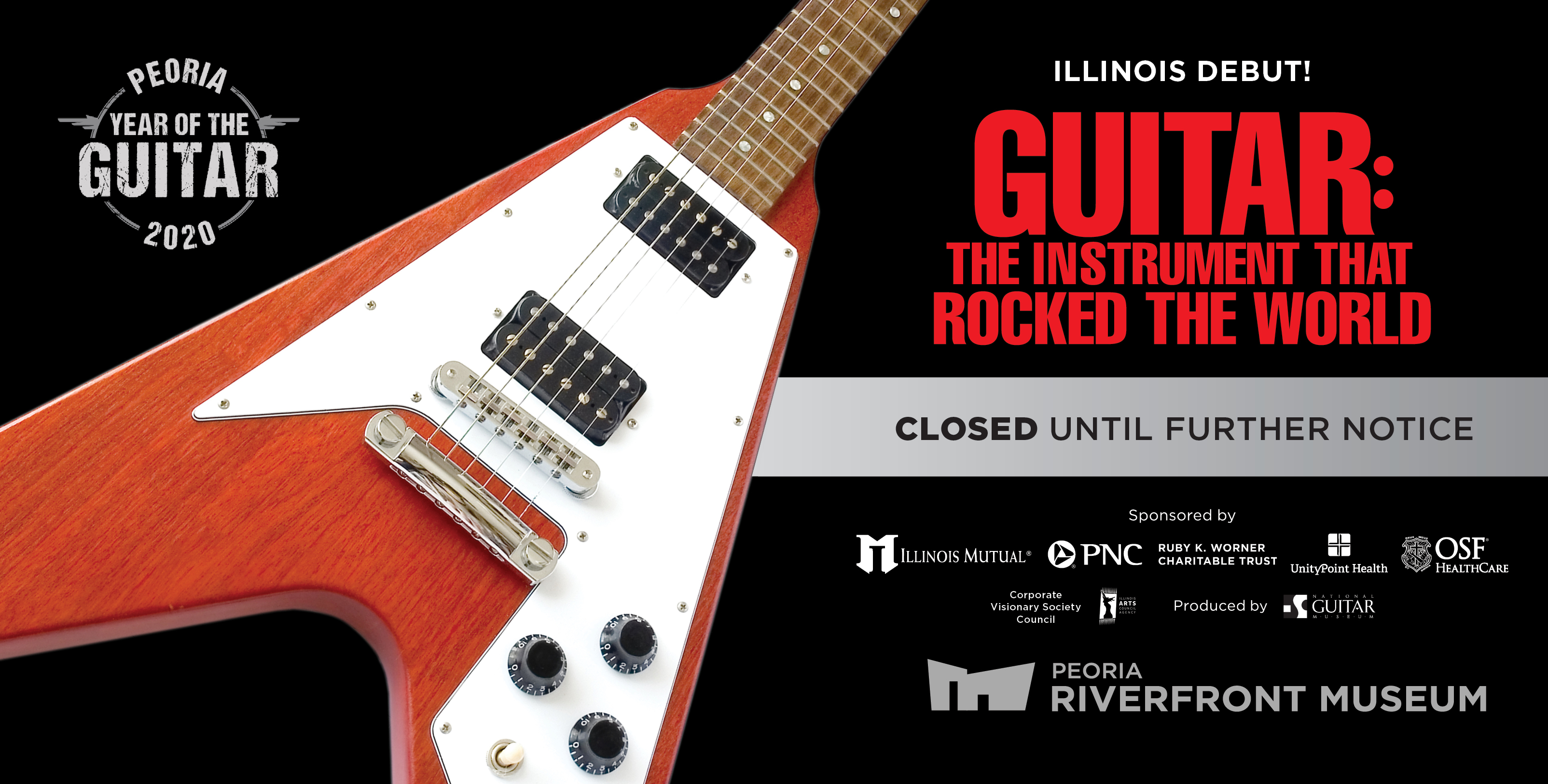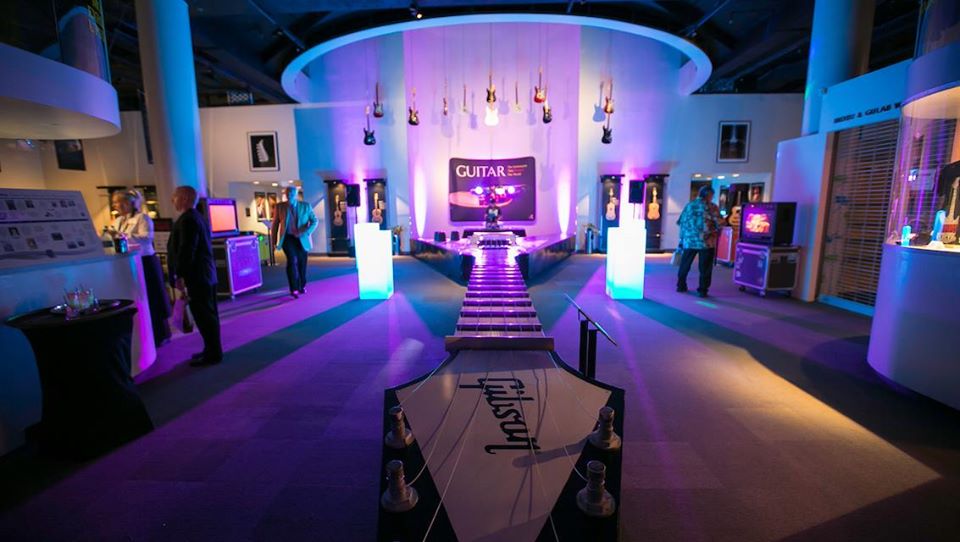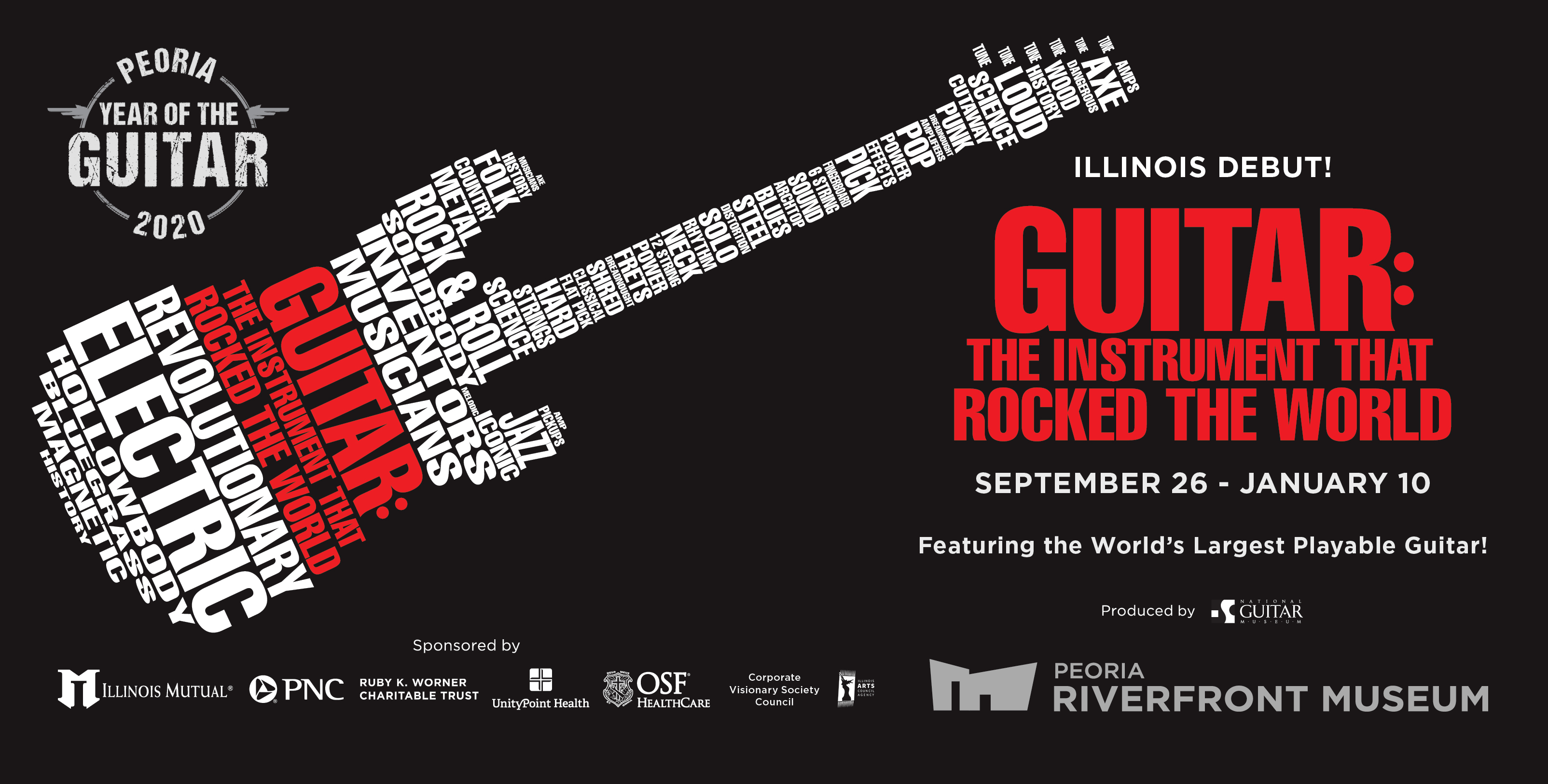
ILLINOIS DEBUT!
GUITAR: The Instrument That Rocked The World
September 26 through January 10 | NOTE: Museum & Exhibition Closed Until Further Notice
International Feature Gallery
FEATURING THE WORLD'S LARGEST PLAYABLE GUITAR!
WIN A GIBSON FLYING V! ENTER TO WIN EACH TIME YOU VISIT THE EXHIBITION! Details HERE!
SEE LIVE GUITAR PERFORMANCES EVERY SATURDAY IN THE EXHIBITION - and on Facebook!
"GUITAR: The Instrument That Rocked The World" takes visitors of all ages on a fascinating and engaging exploration of the art, science, sound, history and pop culture behind the world's most popular instrument! Featuring a unique collection of more than 70 instruments - ranging from the rare and antique to the wildly popular and innovative - along with performance video, models and more,"GUITAR" gives you a chance to enjoy the instrument not only from the perspective of its history, evolution, and design, but through the music it has created and the technology that continues to enhance it.
The guitar is one of the most enduring icons of the past 200 years, evolving from European and Asian instruments during the Middle Ages (oud, sitar, and lute). In "GUITAR," these instruments are displayed side by side next to the guitar as we know it today, with its signature hourglass shape. Packed with STEAM-based elements, GUITAR introduces visitors to concepts including electromagnetism, sound waves, frequency, decibel levels, mathematical scales, engineering design, and materials—along with amplification, memory skills, and performance."GUITAR" explores all facets of the guitar's history as an instrument of popular culture over four centuries to the science of creating sound with wood and steel.
Be inspired! Come explore, play and enjoy "GUITAR"!
Stay "Tuned" for upcoming programs & events at the museum!
DID YOU KNOW?
Legendary guitarist-songwriters Dan Fogelberg and REO Speedwagon's Gary Richrath were both Peoria natives!
PEORIA 2020 | THE YEAR OF THE GUITAR
Experience how it Plays in Peoria and Central Illinois: check out exciting Peoria 2020: The Year of Guitar events around the community on Facebook & Instagram ! #PeoriaYOG
THANK YOU TO OUR SPONSORS
The museum gratefully acknowledges our exhibition presenting sponsors, Illinois Mutual, PNC, Ruby K. Worner Charitable Trust, UnityPoint Health and OSF HealthCare, with additional sponsorship by the Corporate Visionary Society Council and Illinois Arts Council.
"GUITAR: The Instrument That Rocked The World" is produced by The National GUITAR Museum. The NGM was founded to promote and preserve the legacy of the guitar, and is the world's first museum dedicated to the history, science, evolution, and cultural impact of the guitar.
---
SCIENCE OF SOUND | GUITAR INTERACTIVES
Sound From A Tree
It takes many kinds of wood to make a guitar, and guitar makers have to be mindful about using wood that is in danger of being over-forested. The exhibit is a series of woods arranged like a marimba, using woods such as maple, rosewood, mahogany, spruce, and plywood, to demonstrate the difference in tone and volume that each wood produces.
The World’s Largest Guitar
Created by a high school class in Texas and certified by the Guinness Book Of Records, visitors can strum and play this huge instrument and see how stings vibrate on a giant scale.

String Things
Strings are made of catgut, nylon, and steel. Each has its own unique properties.Three guitars are strung with each type of string in a “guitar pyramid.” Visitors strum each guitar and hear—and feel—the difference in each of the materials used to construct the string.
A Box With No Nails (Acoustic Guitar)
The guitar is a marvel of bent wood, carving, and glue ... but no nails.This delicate thin wood box must be able to withstand 200 pounds of string tensions.Two acoustic guitars have been cut open to reveal the “inside workings” of the instrument. Braces are revealed, as are the dimensions of the wood (very thin) and the joints used to keep the pieces together.
Diddley Bow Frequencies
The shorter the string, the higher the frequency.The longer the string, the lower the frequency.Visitors can test this by running a metal tube over the amplified string and listening to the change in pitch. Sliding the tube makes the tone go up or down, depending on the length of the string. A string that is divided in half creates an octave, and even a simple device like this diddley bow conforms to the mathematical increments of music explored by Pythagoras.
Guitar Strobe
A barrel strobe allows visitors to see the vibrations of a string as if it was being played in slow-motion. Different strings vibrate at different frequencies, showing unusual patterns against a guitar backdrop. An oversized guitar with four foot long strings sits over a barrel strobe, that—when spun—captures the waveforms of each string in a truly unique visual presentation.
Gears
The tuning pegs of guitars rely on gears. A table outfitted with large plastic gears in sequence shows visitors how gears work. Users can spin gears of different sizes and will learn that gears next to each other always turn in opposite directions, and that different size gears are used to simplify mechanical tasks.
Inside An Electric Guitar
An electric guitar appears to be a simple device, yet it is made up of electronic components, magnets, different kinds of wood, bits of metal, and plastic. Looking underneath the sleek finish, there’s more to the guitar than meets the eye. Visitors can flip switches, turn knobs, and see inside this Plexiglas instrument.
Pickup Wheel
Visitors generate electromagnetic energy by spinning a wheel with evenly spaced metal pegs under a magnetic pickup. Only when the metal pegs pass by the pickup is a signal generated.The signal generates a sound at a specific pitch.The faster the wheel is spun, the higher the frequency, and thus the higher the pitch.
Music To Your Ears
Using remote sensors, visitors can activate different sounds from different types of stringed instruments by waving their hands over lit panels. Each instrument shows how the combinations of wood, metal, nylon, and electricity are used to create different sounding instruments (from a ukulele to an electric guitar).The sensors are tuned so that users can hear the difference in tonality and can also create musical patterns.
See-Through Amplifiers
The largest guitar amplifiers used by bands on a concert stage are over 6 feet tall.Visitors see into two different amplifiers constructed of Plexiglas. Speakers, tubes, electronic components, and structural elements are all revealed inside these musical monsters, showing how a guitar can be heard all the way to the back of a football stadium. An additional component, using PVC tubing, allows users to experience how forcing air through a space increases its volume.
It Might Get Loud
Decibel levels range from 0 to 194, and visitors can use a touchscreen to find out where everyday sounds fall on the decibel scale.This interactive also warns of the danger of constant exposure to loud noise. A touchscreen mounted inside an amplifier cabinet features 20 different sounds that are activated by the visitor. From a mosquito to a volcano, each sound is registered on a decibel meter that shows just how loud the world around us really is.
Remember The Riff
Listening to guitar riffs that bounce visually on a touchscreen, visitors are encouraged to test their memory in “remembering the riff.” Musicians learn dozens, even hundreds of riffs over their lifetimes, and memory is important to performing and technical ability.This self-directed interactive proceeds from simple riffs to increasingly complex patterns using color as a reinforcement to each activated pitch.
Design Your Own Guitar
Attendees get to choose the colors, patterns, shapes, and even textures in designing their own guitar using this touchscreen interactive.
Focus The Sound
Why are speakers in amplifiers shaped like cones? A simple megaphone provides the answer and shows how cones protect and project the sound coming out of them.
Chladni Plate
The soundboard of every instrument produces vibrations that send sound waves into the air. Using a unique Chladni plate shaped like a guitar soundboard, visitors can see how grains of sand vibrate into very defined shapes and patterns based on the changing frequency of the sound source connected to the interactive.
Groove Tubes
Extended tubes are used to demonstrate how the lengths of vibrating objects affect their vibrations, and thus their frequencies. Visitors smack the opening of the tubes to force air through them and hear different pitches.This interactive also shows how forcing more vibrations into the air makes a sound louder.
FX
Modern sound modification occurs when an electrical signal passes through a device that modifies the shape of the signal and thus its resulting sound waves. This is called applying an effect to the signal. Using simple electronic components like resistors, transistors, and capacitors, a signal from a guitar can be made to repeat, to echo, to distort, and even be made to sound like a human voice.This interactive allows visitors to use effects devices in the form of foot pedals to change a signal and view the results on an oscilloscope while continuously experimenting with different effects.
